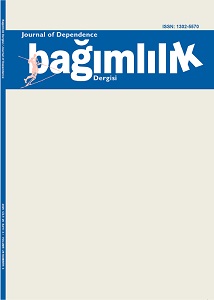PROBLEMATİC INTERNET USE İN CHİLDREN BETWEEN AGES OF 12-18
Keywords:
Dependency, social conditions, social behavior disorderAbstract
Objective: The aim of this study is to investigate the factors affecting internet addiction in children aged 12-18 years.
Method: The study sample consisted of a total of 1956 children aged at 12-18 years old. For this sampling, 3 middle school and 8 high school were selected randomly in Eskişehir. There have been obtained data for demographic properties and internet addiction status by the surveys which applied to children. Existing internet addiction status at the children and effective factors on this addiction were researched by the analyzing the collected data.
Results: Approximately 15% of the children were addicted to internet use, and about 30% of the children were in the risk group. In addition, it was seen that the relationships and demographic characteristics of children with their social environment were effective on internet addiction.
Conclusion: Children with internet addiction have problems in social isolation and control difficulties. However, it was determined that internet addiction is seen as the reason of academic failure and children with low social relations have higher risk of being addicted to internet.
References
Ak Ş, Koruklu N, Yılmaz YA. Study on Turkish adolescent's internet use: possible predictors of internet addiction. Cyberpsychol Behav Soc Netw 2013; 16(3): 205-209.
Beard KW. Internet addiction: a review of current assessment techniques and potential assessment questions. Cyberpsychol Behav 2005; 8 (1): 7–14.
Caplan SE. Relations among loneliness, social anxiety, and problematic internet use. Cyberpsychol 2006; 10(2): 234-242.
Chou C, Condron L, Belland JC. A review of the research on internet addiction. Educ Psychol Rev 2005; 17(4): 363-388.
Easterlin RA. Income and happiness: Towards a unified theory. The Economic Journal 2001; 111(473): 465-484.
Egger O, Rauterberg M. Internet behaviour and addiction. Zurich: Work and Organisaitonal Psycology Unit Swiss Fderal Institute of Technology, 1996.
Greenfield DN. Virtual addiction: Sometimes new technology can create new problems. Psychological Health Associates 2005; Retrieved.
Griffiths MD. Internet addiction: fact or fiction? The Psychologist 1999; 12(5): 246-250.
Günüç S, Kayri M. Türkiye’de internet bağımlılık profili ve internet bağımlılık ölçeğinin geliştirilmesi: Geçerlik-güvenirlik çalışması. Hacettepe Üniversitesi Eğitim Fakültesi Dergisi 2010; 39(39): 220-232.
Holden C. Behavioral addictions: Do they exist? Science 2001; 294: 980-982
Hur MH. Demographic, habitual, and socioeconomic determinants of internet addiction disorder: an empirical study of Korean teenagers. Cyberpsychol Behav 2006; 9(5): 514-525.
Kim S, Kim RA. Study of internet addiction: status, causes, and remedies- focusing on the alienation factor. International Journal of Human Ecology 2002; 3(1):1-19.
Kolmogorov, AN. Foundations of the Theory of Probability, 2.Baskı, Newyork Chelsea Publishing Co. 1933.
Ko CH, Yen JY, Chen CC, et al. Gender differences and related factors affecting online gaming addiction among Taiwanese adolescents. J Nerv Ment Dis 2005; 193(4): 273-277.
Kruskal WH, Wallis WA. Use of ranks in one-criterion variance analysis. J Am Stat Assoc 1952; 47(260): 583-621.
Mann HB, Whitney DR. On a test of whether one of two random variables is stochastically larger than the other. The Annals of Mathematical Statistics 1947: 50-60.
Nestler EJ. Cellular basis of memory for addiction. Dialogues Clin Neurosci 2013; 15(4): 431-443.
Park HS, Kwon YH, Park KM. Factors on internet game addiction among adolescents. J Korean Acad Nurs 2007; 37(5): 754-761.
Ritter C, Hobfoll SE, Lavin J, Cameron RP, et al. Stress, psychosocial resources, and depressive symptomatology during pregnancy in low-income, inner-city women. Health Psychol 2000; 19(6):576-585.
Ruffle JK. Molecular neurobiology of addiction: what’s all the FosB about?. Am J Drug Alcohol Abuse 2014; 40(6): 428-437.
Selfhout MH, Branje, SJ, Delsing M, et al. Different types of Internet use, depression, and social anxiety: The role of perceived friendship quality. J Adolesc 2009; 32(4): 819-833.
Shapiro SS, Wilk MB. An analysis of variance test for normality. Biometrika 1965; 52: 591–611.
Smirnov N. Table for estimating the goodness of fit of empirical distributions. Ann Math Stat 1948; 19: 279–281
Soule LC, Shell LW, Kleen BA. Exploring Internet addiction: Demographic characteristics and stereotypes of heavy Internet users. Journal of Computer Information Systems 2003; 44(1): 64-73.
Türel YK, Toraman M. The relationship between Internet addiction and academic success of secondary school students. Anthropologist 2015; 20(1): 2.
Weiser EB. Gender differences in Internet use patterns and Internet application preferences: A two-sample comparison. Cyberpsychol Behav 2000; 3(2): 167-178.
Yellowlees P, Marks S. Problematic internet use or internet addiction?. Comput Hum Behav 2007; 23(3): 1447-1453.
Downloads
Published
How to Cite
Issue
Section
License
Copyright (c) 2025 Journal of Dependence

This work is licensed under a Creative Commons Attribution-NonCommercial-NoDerivatives 4.0 International License.
...
